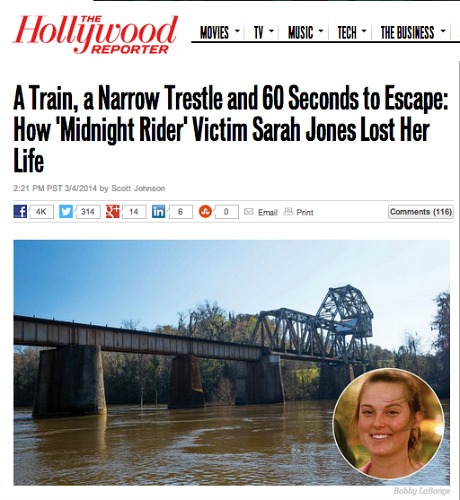Scott Johnson has posted a 3.4 Hollywood Reporter piece about the decisions and circumstances that led to the violent death of Midnight Rider camera assistant Sarah Jones on 2.20. It places the blame squarely on the apparent recklessness of director Randall Miller. No permission from the railroad, no medic, no production coordinator, no safety instructions, no nothing. Miller decided to cut corners and roll the dice so he could get his dream-sequence shot with a bed on the train tracks, and then suddenly the death train was approaching at 60 mph. And now Miller is the new John Landis.

Johnson doesn’t discuss the two most obvious precautions which were also apparently ignored (which I brought up in my 2.20 piece about the tragedy, called “Railroad Chicken“) — i.e., failing to obtain a reliable estimate of when trains would be expected to pass, and failing to place two production assistants with cellphones or long-range walkie-talkies a couple of miles in either direction to give early warning about rogue trains.
My first reaction when I first heard about Jones’ death was “why didn’t she just drop everything and jump off the bridge into the Altamaha River?” That’s what I would have done, no question. To hell with the equipment. I would simply gone over the railing, Butch & Sundance-style.
The problem with this scenario is that Johnson’s description of the accident isn’t specific enough. He doesn’t say if a river jump would have been possible — i.e., if the river was directly below where the crew was shooting on the railroad bridge, and how high the bridge was above the river, and if the water was of sufficient depth to jump into. The only indication is in the following passage, a re-telling of an account of the disaster by hairstylist Joyce Gilliard: “With the train howling past just inches behind her, Gilliard threw herself onto two metal wires that stretched between the girders and along the gangplank, thrust her head out over the river below and shut her eyes.”
If jumping was out, there was another option for production people on the bridge as the death train approached at 60 mph. Dump the equipment on the metal platform or in the river, step over the outside railing and hang onto the bridge trestle from the outside.
Johnson doesn’t speculate about why Jones didn’t think more instinctually in order to save herself, but she apparently tried to save the equipment and generally not abandon her responsibilities just because she was facing the possibility of being killed. That’s certainly admirable from a production point of view. She was a soldier who didn’t turn tail and run when things got scary. But I would have, you can bet.
An excerpt from Johnson’s article:
“From shore, several dozen yards away, a voice shouted to the crew that in the event a train appeared, everyone would have 60 seconds to clear the tracks. ‘Everybody on the crew was tripping over that,’ says Gilliard. ‘A minute? Are you serious?’ By now, she and two other crewmembers were nervous enough that before shooting, they gathered in an informal prayer circle. ‘Lord, please protect us on these tracks,’ murmured Gilliard. ‘ Surround us with your angels and help us, Lord.'”
Wells to Gilliard: The Lord doesn’t protect anybody from anything, ever.
Back to Johnson: “While Gilliard prayed, Jones helped load film, monitor the cameras and transport gear. A fresh-faced South Carolinian with a passion for travel and books, Jones wasn’t really the type to fret much. The crew was filming a dream sequence, and they had placed a twin-size metal-framed bed and mattress in the middle of the tracks.
“Then Gilliard looked up and saw a light in the distance, followed by the immense howl of a locomotive. It was a train — and it was hurtling toward them.
“Two stories high, screaming with the sound of a blast horn and possibly brakes, the train was nearly as wide as the trestle. Gilliard says Miller yelled at everyone to run. Jones, several bags slung over each shoulder, shouted something about what to do with the expensive camera equipment. ‘Drop it!’ Gilliard and others yelled. ‘Just drop it!’
“The only viable escape route to the closest shore lay in running toward the approaching train, now traveling, by one estimate, at almost 60 mph. Gilliard tried to make her way onto the metal gangplank parallel to the tracks. Miller and another crewmember began tugging at the bed, trying to remove it from the train’s path, fearing it might cause a derailment. But as the train approached, Gilliard says, they abandoned their efforts.
“With the train howling past just inches behind her, Gilliard threw herself onto two metal wires that stretched between the girders and along the gangplank, thrust her head out over the river below and shut her eyes.”












